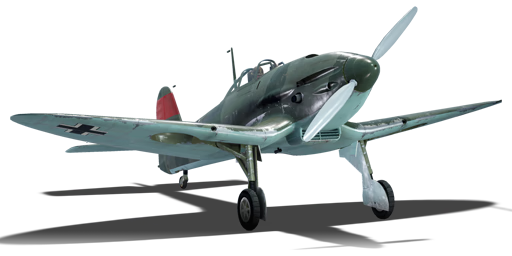



The He 112 B-0 is a German fighter. It has been in the game since the start of the Open Beta Test prior to Update 1.27.
The He 112 B-0 represents the most advanced He 112 variant in the game (after the He 112 V-5 and cannon-armed He 112 A-0). Given all advantages and disadvantages, He 112 B-0 is best played as a universal fighter. If encountering highly agile biplanes, use the He 112's speed to outrun them. If encountering fast, but less agile monoplanes, use agility to out-turn them. And if faced with bombers, nothing shall hold the He 112 back, as the firepower can finish any bomber quickly. That said, the He 112 B-0 can be a quite enjoyable fighter to play, and will serve as a trainer for its successor in the German research tree – the Bf 109 B-1/L, the first version of the legendary Bf 109 fighter series.
It is reasonably fast for a rank II aircraft, while not faster than the Soviet LaGG-3 and Yak fighters, or the American F2A Buffalos and P-36 Hawks – all of them common adversaries of the B-0. It is also quite agile for a monoplane, but will always be out-turned by biplanes or light Japanese fighters such as the A5M4 or Ki-27. Its climb rate is not exactly stellar, but the He 112 B-0 can handle surprisingly high speeds – a red line of 690 km/h is not bad for a rank 2 fighter. While mediocre in manoeuvrability and performance, the strongest trait of this plane is clearly the armament, which is the same as on the Bf 109 E-3 fighter.
flaps
flaps
flaps
brake
| Belt | Belt filling | Armor penetration (mm) at a distance: | |||||
|---|---|---|---|---|---|---|---|
| 10 m | 100 m | 500 m | 1000 m | 1500 m | 2000 m | ||
| IT/IT/APHE | 19 | 18 | 15 | 10 | 4 | 4 | |
| IT/FI-T/FI-T/APHE | 19 | 18 | 15 | 10 | 4 | 4 | |
| FI-T/FI-T/AP-I/APHE/IT | 25 | 24 | 18 | 10 | 1 | 1 | |
| IT/IT/FI-T/FI-T | 10 | 10 | 5 | 2 | 1 | 1 | |
| APHE | 19 | 18 | 15 | 10 | 4 | 4 | |
| Belt | Belt filling | Armor penetration (mm) at a distance: | |||||
|---|---|---|---|---|---|---|---|
| 10 m | 100 m | 500 m | 1000 m | 1500 m | 2000 m | ||
| AP-T/AP-I/AI | 9 | 8 | 6 | 3 | 0 | 0 | |
| AP-T/AP/AI/AP-I | 13 | 12 | 7 | 3 | 2 | 0 | |
| AP-T | 9 | 8 | 6 | 3 | 0 | 0 | |
| AI/AP/AP/AP/AI | 13 | 12 | 7 | 3 | 2 | 0 | |












Flight performance | |
|---|---|
Survivability |
|---|
Weaponry |
|---|